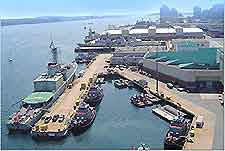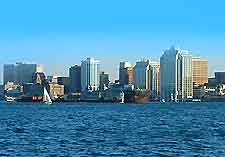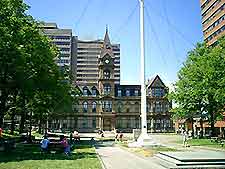Halifax History Facts and Timeline
(Halifax, Nova Scotia, Canada)

No Canadian city east of
Quebec City boasts a more fascinating history or a bigger population than Halifax, the capital of Nova Scotia, which is the easternmost of Canada's three Maritime provinces.
The original residents were native Mi'kmaq, who spent their summers fishing in the Atlantic Ocean for centuries before the first Europeans arrived. Prior to the arrival of British settlers in 1749, French-speaking Acadians established a fishing station in present-day Halifax and lived peacefully with the Mi'kmaq along Nova Scotia's east coast.
Canada's First Permanent British city
In 1749, British general Edward Cornwallis chose Halifax as the location of present-day Canada's first permanent British settlement, because of its large Citadel Hill and impressive natural harbor, the world's second biggest. The Acadians, who were expulsed from Nova Scotia in 1755, were replaced by British loyalists who fled the 13 colonies to the south during the American War of Independence. Many of these loyalists were black slaves hoping to find freedom in Nova Scotia, and descendants of these slaves still live in the city today.
Scalps and Wars
Halifax's early colonial history was marred by conflict as the British and French forces, the latter in cahoots with Acadian and Native American groups, routinely fought, resulting in attacks on the fledling port frontier settlement, the raiding parties taking with them scalps. The Seven Years War eventually saw them expelled from the area. The French Revolution, War of American Independence and War of 1812 all had significant bearing on the city, since it was a primary naval port, and it never fell to the French.
The 19th Century Boom Years
As a significant British military base during the Napoleonic Wars and an important port for trading between the United States and Europe, Halifax flourished throughout most of the 19th century. During this time, Dalhousie University was founded, Province House was constructed and the famous Alexander Keith brewery produced its first beer.
After Halifax's official incorporation in 1841, more prisons, hospitals and schools popped up throughout the city. Halifax became the first stop for numerous immigrants to the New World after Nova Scotia became part of Canada's confederation in 1867. The ocean liner terminal where many of these immigrants docked, Pier 21, now houses Canada's National Museum of Immigration.

The 1917 Halifax Explosion
One of the saddest days in the history of Halifax is 6th December 1917, when a Belgian WWI relief ship and a French munitions ship collided to cause what was then the world's most powerful manmade explosion. About 1,900 people were killed instantly, while countless others were blinded, injured or left homeless after the city's north end was completely flattened during the explosion. Fort Needham's memorial bells still ring each 6th December in remembrance of those who lost their lives in the explosion.
The Great Depression and WWII
Like numerous other cities, Halifax was hit hard by the Great Depression. Several of the city's unemployed single men were assigned restoration work on Citadel Hill, which became a National Defence relief camp. Prosperity improved during WWII, when convoy ships regularly used the harbor. Unfortunately, celebrations of the WWII victory resulted in city-wide riots, which are today known as the Halifax VE-Day riots.
Africville
The surrounding area grew rapidly during the mid-20th century, but this growth came at a terrible price for the residents of Africville. This predominantly black community's 1970 destruction is one of the most shameful events in Halifax history. Africville's residents, most of which descended from British loyalists who first settled in the area after the War of American Independence, were forcefully relocated to other communities after their hometown was destroyed.
Seaview Park was established on Africville's former location, becoming a National Historic Site in 2002. The mayor of Halifax formally apologized for the Africville eviction in 2010. The following year, Seaview Park's name was officially changed back to Africville.

Modern-Day Economy
Today, Halifax is just one of the approximately 200 municipalities which now form the Halifax Regional Municipality. The military remains the city's biggest employer, but it is now joined by growing high-tech, offshore oil and cultural industries.
The local tourism industry has never been healthier thanks in part to the city's steadily increasing multicultural population and thriving arts scene. However, the laid-back atmosphere and friendly maritime hospitality in Halifax remain unchanged.
 No Canadian city east of Quebec City boasts a more fascinating history or a bigger population than Halifax, the capital of Nova Scotia, which is the easternmost of Canada's three Maritime provinces.
No Canadian city east of Quebec City boasts a more fascinating history or a bigger population than Halifax, the capital of Nova Scotia, which is the easternmost of Canada's three Maritime provinces.
